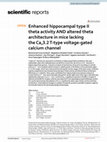Papers by Prof. Dr. Dr. Marco Weiergräber

Medizinische Monatsschrift fur Pharmazeuten, 2017
Pharmacological neuroenhancement and mood enhancement are gaining tremendous importance in societ... more Pharmacological neuroenhancement and mood enhancement are gaining tremendous importance in society. The main motivation for neuroenhancement and mood enhancement is the anticipated increase in attention and vigilance, better performance in learning and memory and mood stability to meet the complex demands of an exacerbating meritocracy. Most users apply drugs originally designated for attention disorders, sleep disorders or dementia. Application of related drugs in terms of enhancement strategies in healthy individuals is off-label per se, the acquisition and distribution illegal. Here, we first provide an overview of the basic physiological mechanisms underlying vigilance, learning and memory, and emotional states. We then present the different pharmacological classes, i. a. purines and methylxanthines, phenylethylamine, modafinil, nootropics and antidepressants and elaborate their pharmacodynamics profile. Special attention will be paid to the norepinephrine/dopamine and cholinerg...

Data in Brief, Jun 1, 2017
Voltage-gated Ca 2 þ channels are of central relevance in mediating numerous intracellular and tr... more Voltage-gated Ca 2 þ channels are of central relevance in mediating numerous intracellular and transcellular processes including excitation-contraction coupling, excitation secretion-coupling, hormone and neurotransmitter release and gene expression. The Ca v 2.3 R-type Ca 2 þ channel is a high-voltage activated channel which plays a crucial role in neurotransmitter release, long-term potentiation and hormone release. Furthermore, Ca v 2.3 R-type channels were reported to be involved in ictogenesis, epileptogenesis, fear behavior, sleep, pre-and postsynaptic integration and rhythmicity within the hippocampus. Ca v 3 T-type Ca 2 þ channels are low-voltage activated and also widely expressed throughout the brain enabling neurons to switch between different firing patterns and to modulate burst activity. Disruption of T-type Ca 2 þ current has been related to sleep disorders, epilepsy, Parkinson's disease, depression, schizophrenia and pain. Ca v 3.2 ablation was further attributed to elevated anxiety and hippocampal alterations resulting in impaired long-term potentiation and memory. Given the importance of Ca v 2.3 and Ca v 3.2 voltage-gated Ca 2 þ channels within the CNS, particularly the hippocampus, we collected gender Contents lists available at ScienceDirect

Scientific Reports, Jan 13, 2021
T-type Ca 2+ channels are assumed to contribute to hippocampal theta oscillations. We used implan... more T-type Ca 2+ channels are assumed to contribute to hippocampal theta oscillations. We used implantable video-EEG radiotelemetry and qPCR to unravel the role of Ca v 3.2 Ca 2+ channels in hippocampal theta genesis. Frequency analysis of spontaneous long-term recordings in controls and Ca v 3.2 −/− mice revealed robust increase in relative power in the theta (4-8 Hz) and theta-alpha (4-12 Hz) ranges, which was most prominent during the inactive stages of the dark cycles. Urethane injection experiments also showed enhanced type II theta activity and altered theta architecture following Ca v 3.2 ablation. Next, gene candidates from hippocampal transcriptome analysis of control and Ca v 3.2 −/− mice were evaluated using qPCR. Dynein light chain Tctex-Type 1 (Dynlt1b) was significantly reduced in Ca v 3.2 −/− mice. Furthermore, a significant reduction of GABA A receptor δ subunits and GABA B1 receptor subunits was observed in the septohippocampal GABAergic system. Our results demonstrate that ablation of Ca v 3.2 significantly alters type II theta activity and theta architecture. Transcriptional changes in synaptic transporter proteins and GABA receptors might be functionally linked to the electrophysiological phenotype.
Alzheimer's Disease - Modernizing Concept, Biological Diagnosis and Therapy

Advances in Experimental Medicine and Biology, 2012
Voltage- and ligand-gated ion channels are key elements in the etiopathogenesis of various forms ... more Voltage- and ligand-gated ion channels are key elements in the etiopathogenesis of various forms of epilepsy. In this chapter, we present an overview of the functional implications of voltage-gated Ca(2+) channels in modulating internal Ca(2+) level fluctuations and generating ictiform/epileptiform cellular electrophysiological activity. A specific focus will be on the fascinating and evolving field of high-voltage activated (HVA) Non-L-type Ca(v)2.3 R-type channels and low-voltage activated (LVA) Ca(v)3.1-3.3 T-type Ca(2+) channels in the genesis of plateau potentials and excessive rebound bursting. Plateau potentials have been characterised in the hippocampus and were shown to be triggered by Ca(v)2.3 which subsequently activate CNG channels that mediate long-lasting plateaus. In the thalamocortical network, a complex ion channel armamentarium is involved in regulating a complex balance of burst and tonic mode activity. Recent findings point to an outstanding role of R- and T-type channels in both thalamocortical eurhythmia and pathophysiological -aberrations. Thus, pharmacological modulation of voltage-gated Ca(2+)-channels might prove more and more important in treatment of neurological and psychiatric disorder such as schizophrenia, mania, dementia and epilepsy.
Neural Plasticity, Feb 23, 2015
Somnologie - Schlafforschung und Schlafmedizin, 2013
Journal of Visualized Experiments
Journal of Visualized Experiments

SummaryCurrent concepts regarding the biology of aging are based on studies aimed at identifying ... more SummaryCurrent concepts regarding the biology of aging are based on studies aimed at identifying factors regulating natural lifespan. However, lifespan as a sole proxy measure for aging can be of limited value because it may be restricted by specific sets of pathologies, rather than by general physiological decline. Here, we employed large-scale phenotyping to analyze hundreds of phenotypes and thousands of molecular markers across tissues and organ systems in a single study of aging male C57BL/6J mice. For each phenotype, we established lifetime profiles to determine when age-dependent phenotypic change is first detectable relative to the young adult baseline. We examined central genetic and environmental lifespan regulators (putative anti-aging interventions, PAAIs; the following PAAIs were examined: mTOR loss-of-function, loss-of-function in growth hormone signaling, dietary restriction) for a possible countering of the signs and symptoms of aging. Importantly, in our study desig...

A Ca<sub>v</sub>3.2<sup>+/+</sup> mouse (internal #146) was implanted wit... more A Ca<sub>v</sub>3.2<sup>+/+</sup> mouse (internal #146) was implanted with an intrahippocampal electrode for electrohippocampal CA1 EEG recordings. The differential electrode of the TA10ETA-F20 transmitter (Data Science International, DSI, USA, technical specifications: weight 3.9 g, volume 1.9 cc, input voltage range ± 2.5 mV, channel bandwidth (B) 1–200 Hz, nominal sampling rate (f) 1000 Hz (f = 5 B), temperature operating range 34–41 °C) was positioned at the following stereotaxic coordinates: (+)-lead, caudal − 2 mm, lateral of bregma 1.5 mm (right hemisphere), and dorsoventral (depth) 1.5 mm. The epidural reference electrode was positioned on the surface of the cerebellar cortex at the following stereotaxic coordinates: (−)-lead, bregma − 6 mm and lateral of bregma 1 mm (right<br> hemisphere). The deep tungsten electrodes (FHC, USA) are encapsuled with epoxylite with an<br> impedance of 50–100 kΩ (measured at 1000 Hz) and a shank diameter of ...

A Ca<sub>v</sub>3.2+/+ mouse (internal #38) was implanted with an intrahippocampal el... more A Ca<sub>v</sub>3.2+/+ mouse (internal #38) was implanted with an intrahippocampal electrode for electrohippocampal CA1 EEG recordings. The differential electrode of the TA10ETA-F20 transmitter (Data Science International, DSI, USA, technical specifications: weight 3.9 g, volume 1.9 cc, input voltage range ± 2.5 mV, channel bandwidth (B) 1–200 Hz, nominal sampling rate (f) 1000 Hz (f = 5 B), temperature operating range 34–41 °C) was positioned at the following stereotaxic coordinates: (+)-lead, caudal − 2 mm, lateral of bregma 1.5 mm (right hemisphere), and dorsoventral (depth) 1.5 mm. The epidural reference electrode was positioned on the surface of the cerebellar cortex at the following stereotaxic coordinates: (−)-lead, bregma − 6 mm and lateral of bregma 1 mm (right<br> hemisphere). The deep tungsten electrodes (FHC, USA) are encapsuled with epoxylite with an<br> impedance of 50–100 kΩ (measured at 1000 Hz) and a shank diameter of 250 μm. For further deta...

A Ca<sub>v</sub>3.2<sup>+/+</sup> mouse (internal #406) was implanted wit... more A Ca<sub>v</sub>3.2<sup>+/+</sup> mouse (internal #406) was implanted with an intrahippocampal electrode for electrohippocampal CA1 EEG recordings. The differential electrode of the TA10ETA-F20 transmitter (Data Science International, DSI, USA, technical specifications: weight 3.9 g, volume 1.9 cc, input voltage range ± 2.5 mV, channel bandwidth (B) 1–200 Hz, nominal sampling rate (f) 1000 Hz (f = 5 B), temperature operating range 34–41 °C) was positioned at the following stereotaxic coordinates: (+)-lead, caudal − 2 mm, lateral of bregma 1.5 mm (right hemisphere), and dorsoventral (depth) 1.5 mm. The epidural reference electrode was positioned on the surface of the cerebellar cortex at the following stereotaxic coordinates: (−)-lead, bregma − 6 mm and lateral of bregma 1 mm (right<br> hemisphere). The deep tungsten electrodes (FHC, USA) are encapsuled with epoxylite with an<br> impedance of 50–100 kΩ (measured at 1000 Hz) and a shank diameter of ...

Scientific Reports, 2017
Maternal folic acid (FA) supplementation prior to and during gestation is recommended for the pre... more Maternal folic acid (FA) supplementation prior to and during gestation is recommended for the prevention of neural tube closure defects in the developing embryo. Prior studies, however, suggested that excessive FA supplementation during gestation can be associated with toxic effects on the developing organism. Here, we address whether maternal dietary folic acid supplementation at 40 mg/ kg chow (FD), restricted to a period prior to conception, affects neurobehavioural development in the offspring generation. Detailed behavioural analyses showed reversal learning impairments in the Morris water maze in offspring derived from dams exposed to FD prior to conceiving. Furthermore, offspring of FD dams showed minor and transient gene expression differences relative to controls. Our data suggest that temporary exposure of female germ cells to FD is sufficient to cause impaired cognitive flexibility in the subsequent generation.
International Journal of Molecular Sciences, Mar 22, 2022
This article is an open access article distributed under the terms and conditions of the Creative... more This article is an open access article distributed under the terms and conditions of the Creative Commons Attribution (CC BY

A Ca<sub>v</sub>3.2<sup>+/+</sup> mouse (internal #383) was implanted wit... more A Ca<sub>v</sub>3.2<sup>+/+</sup> mouse (internal #383) was implanted with an intrahippocampal electrode for electrohippocampal CA1 EEG recordings. The differential electrode of the TA10ETA-F20 transmitter (Data Science International, DSI, USA, technical specifications: weight 3.9 g, volume 1.9 cc, input voltage range ± 2.5 mV, channel bandwidth (B) 1–200 Hz, nominal sampling rate (f) 1000 Hz (f = 5 B), temperature operating range 34–41 °C) was positioned at the following stereotaxic coordinates: (+)-lead, caudal − 2 mm, lateral of bregma 1.5 mm (right hemisphere), and dorsoventral (depth) 1.5 mm. The epidural reference electrode was positioned on the surface of the cerebellar cortex at the following stereotaxic coordinates: (−)-lead, bregma − 6 mm and lateral of bregma 1 mm (right<br> hemisphere). The deep tungsten electrodes (FHC, USA) are encapsuled with epoxylite with an<br> impedance of 50–100 kΩ (measured at 1000 Hz) and a shank diameter of ...

Neurobiology of Aging, 2019
Electrophysiology provides a real-time readout of neural functions and network capability in diff... more Electrophysiology provides a real-time readout of neural functions and network capability in different brain states, on temporal (fractions of milliseconds) and spatial (micro, meso, and macro) scales unmet by other methodologies. However, current international guidelines do not endorse the use of electroencephalographic (EEG)/magnetoencephalographic (MEG) biomarkers in clinical trials performed in patients with Alzheimer's disease (AD), despite a surge in recent validated evidence. This position paper of the ISTAART Electrophysiology Professional Interest Area endorses consolidated and translational electrophysiological techniques applied to both experimental animal models of AD and patients, to probe the effects of AD neuropathology (i.e., brain amyloidosis, tauopathy, and neurodegeneration) on neurophysiological mechanisms underpinning neural excitation/inhibition and neurotransmission as well as brain network dynamics, synchronization, and functional connectivity, reflecting thalamocortical and corticocortical residual capacity. Converging evidence shows relationships between abnormalities in EEG/MEG markers and cognitive deficits in groups of AD patients at different disease stages. The supporting evidence for the application of electrophysiology in AD clinical research as well as drug discovery pathways warrants an international initiative to include the use of EEG/MEG biomarkers in the main multicentric projects planned in AD patients, to produce conclusive findings challenging the present regulatory requirements and guidelines for AD studies.











Uploads
Papers by Prof. Dr. Dr. Marco Weiergräber